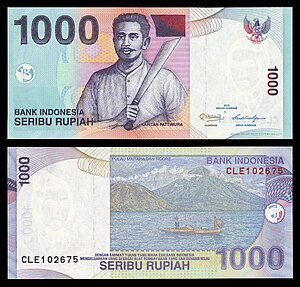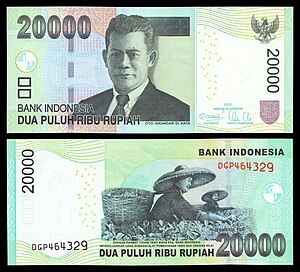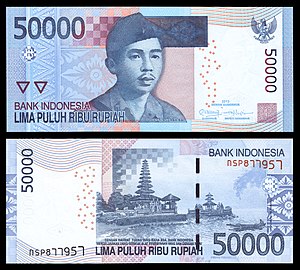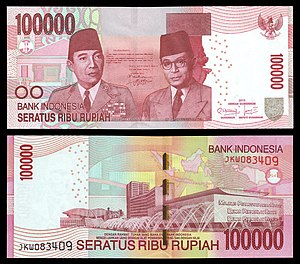|
Featured picture tools: |
These featured pictures, as scheduled below, appeared as the picture of the day (POTD) on the English Wikipedia's Main Page in August 2018. Individual sections for each day on this page can be linked to with the day number as the anchor name (e.g. [[Wikipedia:Picture of the day/August 2018#1]] for August 1).
You can add an automatically updating POTD template to your user page using {{Pic of the day}} (version with blurb) or {{POTD}} (version without blurb). For instructions on how to make custom POTD layouts, see Wikipedia:Picture of the day.Purge server cache
August 1

|
The I-35W Mississippi River bridge was an eight-lane, steel truss arch bridge that carried Interstate 35W across the Saint Anthony Falls of the Mississippi River in Minneapolis, Minnesota. Once the third-busiest bridge in the state, it suddenly collapsed on August 1, 2007, killing 13 and injuring 145. Rescue of people stranded on the bridge was complete in three hours, while recovery of bodies—involving 75 local, state and federal agencies—took three weeks. An NTSB investigation cited a design flaw as the likely cause of the collapse, noting that a too-thin gusset plate ripped along a line of rivets. Photograph: Kevin Rofidal, United States Coast Guard; edit: Papa Lima Whiskey
Recently featured:
|
August 2

|
Hollow Horn Bear (1850–1913) was a Brulé Lakota leader, who fought in many battles, including Little Bighorn. As police chief of the Rosebud Reservation, he arrested Crow Dog for the murder of Spotted Tail and testified before the Supreme Court of the United States in Ex parte Crow Dog. He was the chief orator for the Lakota, and took part in the inaugural parades for Theodore Roosevelt and Woodrow Wilson. He was featured on a 1922 postage stamp and the 1970 $10 Military Payment Certificate, and was possibly the basis for other depictions of Native Americans including the US five-dollar bill. Photograph: Library of Congress Harris & Ewing collection; restoration: GreenMeansGo
Recently featured:
|
August 3

|
A Fallah Woman with Her Child, an oil painting on canvas completed by Elisabeth Jerichau-Baumann in 1878. The main subject is a fallah woman, a peasant or farmer, distinguished from the effendi land-owning class. It is held by the Statens Museum for Kunst in Copenhagen. A Polish-Danish painter who had studied at the Kunstakademie Düsseldorf, Jerichau-Baumann (1819–1881) completed this and similar works based on her experiences travelling the Ottoman Empire in 1869–1870 and 1874–1875. Unlike many of her contemporaries, she had access to the region's harems and could base her paintings on personal observation. Many of her subjects insisted on being painted in the latest Paris fashions, and Jerichau-Baumann depicted them with a fine sense of colour and lighting. Owing to their sensualism, some of these paintings were hidden by the contemporary European art world, often relegated to storage rooms. Painting: Elisabeth Jerichau-Baumann
Recently featured:
|
August 4

|
A Julia butterfly (Dryas iulia) feeding on the tears of a red-headed Amazon River turtle (Podocnemis erythrocephala) in Ecuador. Such lachryphagy provides the butterfly with additional minerals that it can use for spermatophore production. Photograph: Ministry of Information and Tourism of Ecuador
Recently featured:
|
August 5

|
Ambroise Thomas (1811–1896) was a French composer best known for his operas Mignon (1866) and Hamlet (1868, after Shakespeare). The son of two music teachers, Thomas was playing the piano and violin by age ten. He completed his first opera, La double échelle, in 1837, and wrote 23 further operas over the next decades. In 1871, he was appointed director of the Conservatoire de Paris, holding this position until his death. Photograph: Wilhelm Benque; restoration: Adam Cuerden
Recently featured:
|
August 6

|
The rufous-tailed flycatcher (Myiarchus validus) is a species of tyrant flycatcher endemic to Jamaica. Photograph: Charles J. Sharp
Recently featured:
|
August 7

|
View of Delft is an oil painting on canvas by Johannes Vermeer, painted c. 1660–1661. Depicting the artist's hometown Delft, it was completed at a time when cityscapes were uncommon, and has become one of Vermeer's most popular works. It is one of three known paintings of the city by Vermeer, along with The Little Street and the lost painting House Standing in Delft. The use of pointillism suggests that the painting, which is held by the Mauritshuis in The Hague, postdates The Little Street. Painting: Johannes Vermeer
Recently featured:
|
August 8

|
An Indian Head gold piece in the denomination five American dollars (a half eagle). The same design by Augustus Saint-Gaudens as the eagle and double eagle was originally to be used, but this design by Boston sculptor Bela Pratt was chosen instead. Struck from 1908 to 1916, and in 1929, the Indian Head half eagle is one of only two U.S. circulating coins with recessed (incuse) designs. Coin: United States Mint; photograph: Jaclyn Nash/National Numismatic Collection
Recently featured:
|
August 9

|
Chrysopa perla is a species of insect in the family Chrysopidae. Present in most of Europe and in temperate zones of Asia, these insects prefer cool and shady areas. They may reach 10–12 millimetres (0.39–0.47 in) in length, with a wingspan of 25–30 millimetres (0.98–1.18 in). Photograph: Mathias Krumbholz
Recently featured:
|
August 10

|
A three pence note of "Marshall Hole currency", issued in Bulawayo in 1900. Owing to the shortage of small change and circulating coinage in Rhodesia during the Second Boer War, Hugh Marshall Hole, Government Secretary for Matabeleland, authorised the use of small cards bearing a British South Africa Company postage stamp on the obverse, and an official handstamped signature on the reverse. These cards circulated as emergency currency between 1 August 1900 and their withdrawal on 1 October 1900. A total of £20,000 worth of stamps were used, in denominations of 2d, 3d, 4d, 6d, 1/-, 2/-, 2/6, 4/-, 5/- and 10/-. Banknote: Office of Hugh Marshall Hole (image courtesy of the National Numismatic Collection, National Museum of American History)
Recently featured:
|
August 11

|
A map of Margarita Island, the largest island in the Venezuelan state of Nueva Esparta. Situated off the northeastern coast of the country, in the Caribbean Sea, it is the site of the state capital, La Asunción. Primary industries of this island, which covers 1,020 sq km (390 sq mi), are tourism, fishing and construction. Map: The Photographer
Recently featured:
|
August 12

|
Cigaritis cilissa foraging at Mount Meron, Israel. This species of butterfly is endemic to the Middle East. Photograph: Gideon Pisanty
Recently featured:
|
August 13

|
The Rape of the Daughters of Leucippus is an oil painting on canvas completed by Peter Paul Rubens in 1618 and presently in the collection of the Alte Pinakothek in Munich, Germany. It depicts a Greek myth in which the mortal Castor and the immortal Pollux abduct Phoebe and Hilaeira, daughters of Leucippus. In the myth, the sisters' fiancés, Idas and Lynceus, track the kidnappers, slaying Castor before falling in battle. Painting: Peter Paul Rubens
Recently featured:
|
August 14

|
A filling station in Sabah, Malaysia, operated by Royal Dutch Shell. Filling stations, also known under a wide variety of names, are facilities that sell fuel and engine lubricants for motor vehicles. They include one or more fuel dispensers, which distribute fuels such as gasoline and diesel into the tanks within vehicles and calculate the financial cost of the fuel transferred. Filling stations may also include air compressors and electricity sockets, which may inflate tyres or offer charging stations. Many filling stations also incorporate a convenience store, where customers can purchase snacks and other goods. Photograph: Uwe Aranas
Recently featured:
|
August 15

|
A Passiflora caerulea flower, photographed at Ljubljana Botanical Garden in Slovenia. This species of flowering plant is native to South America. It is a vigorous, deciduous or semi-evergreen tendril vine, with palmate leaves and fragrant, blue-white flowers with a prominent fringe of coronal filaments in bands of blue, white, and brown. It may grow to 10 m (33 ft) or more. Photograph: Petar Milošević
Recently featured:
|
August 16

|
The Hollywood Sign is an American landmark and cultural icon located in Los Angeles, California. Situated on Mount Lee, in the Hollywood Hills area of the Santa Monica Mountains, it overlooks the city's Hollywood neighborhood. The sign was originally created in 1923 as an advertisement for a local real estate development, but due to increasing recognition, the sign was left up. Frequently targeted for pranks and vandalism, it has undergone restoration several times, including the installation of a security system. Viewed from lower ground, the contours of the hills give the sign a wavy appearance; when viewed from the same height, the word "HOLLYWOOD" appears nearly straight. The sign is common in popular culture, and signs of a similar style are frequently seen as parodies. Photograph: Thomas Wolf
Recently featured:
|
August 17

|
Hunter's Home is an oil painting by Henry Voordecker held by the Rijksmuseum in Amsterdam. A typical genre painting, it depicts a hunter at home, surrounded by animals and members of his family. The work is in a Biedermeier style, and its themes are characterized by the reinforced feelings of security, gemütlichkeit, and traditional simplicity, portraying a sentimental view of the world. Painting: Henry Voordecker
Recently featured:
|
August 18
Subpage 1

|
The rupiah is the national currency of Indonesia. Introduced in 1946 by Indonesian nationalists fighting for independence, the currency replaced a version of the Netherlands Indies gulden which had been introduced during the Japanese occupation in World War II. In its early years the rupiah was used in conjunction with other currencies, including a new version of the gulden introduced by the Dutch. Since 1950, it has had a lengthy history of inflation and revaluation. As of August 2018[update], the currency—which is issued and controlled by the Bank of Indonesia—is trading for more than 14,600 rupiah to the United States dollar. This note, denominated 1,000 rupiah, is part of the 2000 series. It depicts Pattimura, a National Hero of Indonesia, on its obverse, and the islands of Maitara and Tidore on its reverse. See other denominations: Rp 2,000, Rp 5,000, Rp 10,000, Rp 20,000, Rp 50,000, Rp 100,000 Banknotes: Bank of Indonesia
Recently featured:
|
Subpage 2

|
The rupiah is the national currency of Indonesia. Introduced in 1946 by Indonesian nationalists fighting for independence, the currency replaced a version of the Netherlands Indies gulden which had been introduced during the Japanese occupation in World War II. In its early years the rupiah was used in conjunction with other currencies, including a new version of the gulden introduced by the Dutch. Since 1950, it has had a lengthy history of inflation and revaluation. As of August 2018[update], the currency—which is issued and controlled by the Bank of Indonesia—is trading for more than 14,600 rupiah to the United States dollar. This note, denominated 2,000 rupiah, is part of the 2009 series. It depicts Prince Antasari, a National Hero of Indonesia, on its obverse, and a traditional Dayak dance on its reverse. See other denominations: Rp 1,000, Rp 5,000, Rp 10,000, Rp 20,000, Rp 50,000, Rp 100,000 Banknotes: Bank of Indonesia
Recently featured:
|
Subpage 3

|
The rupiah is the national currency of Indonesia. Introduced in 1946 by Indonesian nationalists fighting for independence, the currency replaced a version of the Netherlands Indies gulden which had been introduced during the Japanese occupation in World War II. In its early years the rupiah was used in conjunction with other currencies, including a new version of the gulden introduced by the Dutch. Since 1950, it has had a lengthy history of inflation and revaluation. As of August 2018[update], the currency—which is issued and controlled by the Bank of Indonesia—is trading for more than 14,600 rupiah to the United States dollar. This note, denominated 5,000 rupiah, is part of the 2009 series. It depicts Tuanku Imam Bonjol, a National Hero of Indonesia, on its obverse, and a West Sumatran weaver on its reverse. See other denominations: Rp 1,000, Rp 2,000, Rp 10,000, Rp 20,000, Rp 50,000, Rp 100,000 Banknotes: Bank of Indonesia
Recently featured:
|
Subpage 4

|
The rupiah is the national currency of Indonesia. Introduced in 1946 by Indonesian nationalists fighting for independence, the currency replaced a version of the Netherlands Indies gulden which had been introduced during the Japanese occupation in World War II. In its early years the rupiah was used in conjunction with other currencies, including a new version of the gulden introduced by the Dutch. Since 1950, it has had a lengthy history of inflation and revaluation. As of August 2018[update], the currency—which is issued and controlled by the Bank of Indonesia—is trading for more than 14,600 rupiah to the United States dollar. This note, denominated 10,000 rupiah, is from a 2010 revision of an earlier series. It depicts Mahmud Badaruddin II, a National Hero of Indonesia, on its obverse, and a rumah limas on its reverse. See other denominations: Rp 1,000, Rp 2,000, Rp 5,000, Rp 20,000, Rp 50,000, Rp 100,000 Banknotes: Bank of Indonesia
Recently featured:
|
Subpage 5

|
The rupiah is the national currency of Indonesia. Introduced in 1946 by Indonesian nationalists fighting for independence, the currency replaced a version of the Netherlands Indies gulden which had been introduced during the Japanese occupation in World War II. In its early years the rupiah was used in conjunction with other currencies, including a new version of the gulden introduced by the Dutch. Since 1950, it has had a lengthy history of inflation and revaluation. As of August 2018[update], the currency—which is issued and controlled by the Bank of Indonesia—is trading for more than 14,600 rupiah to the United States dollar. This note, denominated 20,000 rupiah, is from a 2011 revision of an earlier series. It depicts Oto Iskandar di Nata, a National Hero of Indonesia, on its obverse, and Sundanese tea farmers on its reverse. See other denominations: Rp 1,000, Rp 2,000, Rp 5,000, Rp 10,000, Rp 50,000, Rp 100,000 Banknotes: Bank of Indonesia
Recently featured:
|
Subpage 6

|
The rupiah is the national currency of Indonesia. Introduced in 1946 by Indonesian nationalists fighting for independence, the currency replaced a version of the Netherlands Indies gulden which had been introduced during the Japanese occupation in World War II. In its early years the rupiah was used in conjunction with other currencies, including a new version of the gulden introduced by the Dutch. Since 1950, it has had a lengthy history of inflation and revaluation. As of August 2018[update], the currency—which is issued and controlled by the Bank of Indonesia—is trading for more than 14,600 rupiah to the United States dollar. This note, denominated 50,000 rupiah, is from a 2011 revision of an earlier series. It depicts I Gusti Ngurah Rai, a National Hero of Indonesia, on its obverse, and Bratan Temple on its reverse. See other denominations: Rp 1,000, Rp 2,000, Rp 5,000, Rp 10,000, Rp 20,000, Rp 100,000 Banknotes: Bank of Indonesia
Recently featured:
|
Subpage 7

|
The rupiah is the national currency of Indonesia. Introduced in 1946 by Indonesian nationalists fighting for independence, the currency replaced a version of the Netherlands Indies gulden which had been introduced during the Japanese occupation in World War II. In its early years the rupiah was used in conjunction with other currencies, including a new version of the gulden introduced by the Dutch. Since 1950, it has had a lengthy history of inflation and revaluation. As of August 2018[update], the currency—which is issued and controlled by the Bank of Indonesia—is trading for more than 14,600 rupiah to the United States dollar. This note, denominated 100,000 rupiah, is from a 2011 revision of an earlier series. It depicts Sukarno and Mohammad Hatta, respectively Indonesia's first president and vice-president, on its obverse, and the People's Consultative Assembly building on its reverse. See other denominations: Rp 1,000, Rp 2,000, Rp 5,000, Rp 10,000, Rp 20,000, Rp 50,000 Banknotes: Bank of Indonesia
Recently featured:
|
August 19

|
The Broderie Room at the Phipps Conservatory and Botanical Gardens in Pittsburgh, Pennsylvania, during the winter flower show of 2015. Also known as the Parterre de Broderie ("embroidery of earth"), the Broderie Room is located in the south part of the east wing. The garden is modelled after the formal gardens of French chateaux during the reign of Louis XIV, and is a popular setting for wedding ceremonies and photo shoots. The room opened in 1939 and was originally called the Cloister Garden; it was renamed the Broderie Room in 1966. Photograph: Dllu
Recently featured:
|
August 20

|
Benjamin Harrison (1833–1901) was a politician and lawyer who served as the 23rd President of the United States from 1889 to 1893. Before ascending to the presidency, Harrison established himself as a prominent local attorney, church leader, and politician in Indianapolis, Indiana, and as a Union Army soldier in the American Civil War. After a term in the U.S. Senate (1881–1887), the Republican Harrison was elected to the presidency in 1888. Hallmarks of his administration included unprecedented economic legislation, including the McKinley Tariff and Sherman Antitrust Act, as well as modernizing the U.S. Navy and admitting six new western states to the Union. Engraving: Bureau of Engraving and Printing; restoration: Andrew Shiva
Recently featured:
|
August 21

|
The PlayStation Vita is a handheld game console developed and released by Sony Computer Entertainment. The successor to the PlayStation Portable, it was designed to meld the experience of dedicated video game platforms with mobile gaming. Released between 2011 and 2012, the system was successful on launch; however, sales faltered in later years, precipitating a shift from big budget games to indie developers and mid-level Japanese companies. The system, which has seen several variations, primarily competes with the Nintendo 3DS as part of the eighth generation of video game consoles. Photograph: Evan Amos
Recently featured:
|
August 22
|
A Visit to the Seaside, a 1908 film directed by British filmmaker George Albert Smith. This work was the first film screened using Kinemacolor, a color motion picture process developed by Smith and used commercially from 1908 to 1914. This additive two-color process involved photographing and projecting a black-and-white film behind alternating red and green filters. It was later used for films such as With Our King and Queen Through India (1912), The World, the Flesh and the Devil (1914), and Little Lord Fauntleroy (1914). Film: George Albert Smith
Recently featured:
|
August 23

|
Belshazzar's Feast is an oil painting completed by the Dutch artist Rembrandt in 1635. Drawing on the Biblical Book of Daniel, it depicts the Neo-Babylonian king Belshazzar holding a feast using sacred vessels looted from the Temple in Jerusalem; God, angered by this blasphemy, has inscribed the following writing on the wall: "God has numbered the days of your kingdom and brought it to an end; you have been weighed in the balances and found wanting; your kingdom is given to the Medes and Persians". This painting, which has been seen as Rembrandt's attempt to establish himself as a painter of large, baroque history paintings, is in the National Gallery, London. Painting: Rembrandt
Recently featured:
|
August 24

|
Nembrotha cristata is a colourful species of sea slug. This nudibranch, a marine gastropod in the family Polyceridae, lives on rocks or coral reefs in the tropical Indo-West Pacific Ocean. This species of sea slug is black with green markings. Adults reach lengths of around 50 mm. Photograph: Steve Childs
Recently featured:
|
August 25

|
A gold coin, issued by the Second Mexican Empire in 1866, in the denomination of 20 pesos. It depicts Maximilian I of Mexico (r. 1864–67) on its obverse, with the coat of arms of Mexico on its reverse. Mexico still uses the peso as its currency, although the original peso was replaced in 1993 with the new peso, which had 1000 times the value of its predecessor. Photograph: National Numismatic Collection, National Museum of American History
Recently featured:
|
August 26

|
Madame Moitessier is the title of a portrait of Marie-Clotilde-Inès Moitessier (née de Foucauld) begun in 1844 and completed in 1856 by Jean-Auguste-Dominique Ingres. When first requested to paint Moitessier, Ingres refused; however, upon meeting her and being struck by her beauty, he agreed to take the commission. His first portrait, shown here, depicts Moitessier seated and draws inspiration from the frescoes of Herculaneum. It is now in the National Gallery in London. Painting: Jean-Auguste-Dominique Ingres
Recently featured:
|
August 27

|
The Abbey of Saint-Michel-de-Cuxa is a Benedictine abbey located in Codalet, France. Founded at its present site in 878, it survived as a monastery for over 900 years, but was closed and sold by the government following the French Revolution of 1789, and fell into disrepair. It was refounded in 1919 and subsequently restored by the Cistercians—an order which had originated as a reformist offshoot of the Benedictines—before being returned to the latter in 1965. Parts of the original building are incorporated in The Cloisters museum in New York City. Photograph: Cancre
Recently featured:
|
August 28

|
Goethe in the Roman Campagna is an oil painting on canvas completed in 1787 by the German Neoclassical artist Johann Heinrich Wilhelm Tischbein. It depicts Johann Wolfgang von Goethe whilst the writer was travelling in Italy between 1786 and 1788; diaries from this journey served as the basis for his Italian Journey (1816–17). Since 1887, the painting has been held by the Städel Museum in Goethe's hometown, Frankfurt. Painting: Johann Heinrich Wilhelm Tischbein
Recently featured:
|
August 29

|
The River Wensum is a chalk river in Norfolk, England and a tributary of the River Yare. The river has its source in north-west Norfolk, and passes through Fakenham and Norwich. Boys Bathing on the River Wensum is an 1817 oil painting by John Crome, depicting the Wensum at the New Mills area of Norwich. Art historian Andrew Hemingway has identified leisure as a common theme in Crome's work, citing this work as an example. Painting: John Crome
Recently featured:
|
August 30

|
Charlotte Perkins Gilman (1860–1935) was an American feminist, writer and lecturer. She grew up in poverty in New England. After the break-up of her marriage in 1888, she moved to Pasadena, California, where she became involved with feminist organizations and began writing poetry and short stories on feminism. This included "The Yellow Wallpaper", which was published in The New England Magazine in 1892 and is the all-time bestselling title published by the Feminist Press. Inspired by Gilman's own experience, it describes a woman who descends into madness while trapped in a room by her husband. She went on to become a lecturer, touring locations across the United States. Photograph: C.F. Lummis |
August 31

|
Anartia jatrophae, also known as the white peacock, is a species of butterfly found in the southeastern United States, Central America, and throughout much of South America. The males of this species are territorial, and will protect an area approximately 15 m (50 ft) in diameter from other insects. Photograph: Charles J. Sharp |
Picture of the day archives and future dates